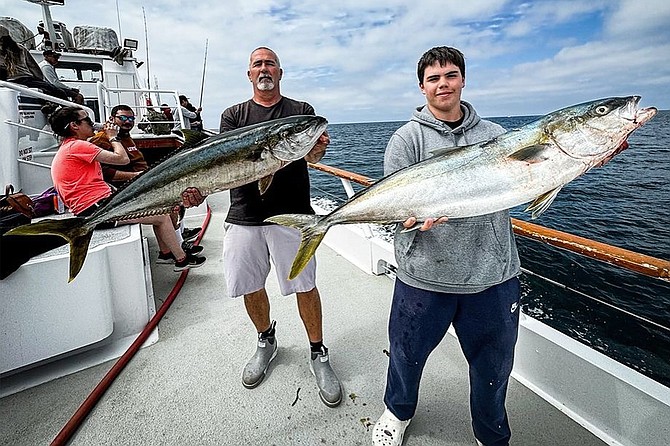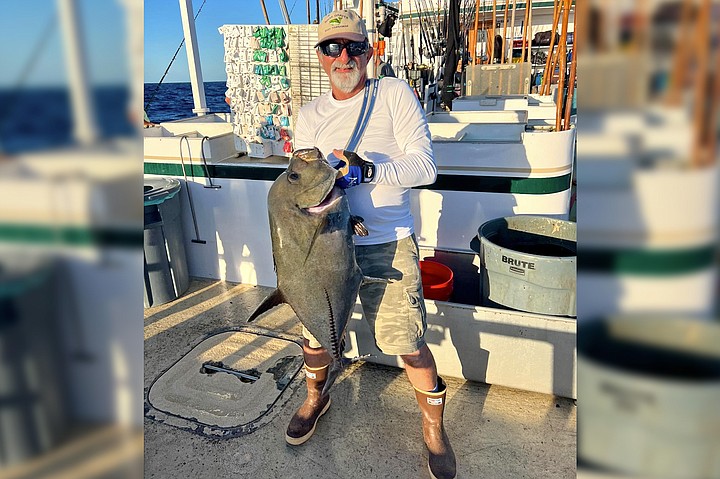 Facebook
Facebook
 X
X
 Instagram
Instagram
 TikTok
TikTok
 Youtube
Youtube

Dock Totals 3/17 – 3/23: 1003 anglers aboard 44 half-day to 3-day trips out of San Diego landings over the past week caught 172 bluefin tuna (up to 160-pounds), 23 calico bass, 29 halibut, 92 lingcod, 16 lobster (72 released), 2 perch, 2 rock crab, 442 rockfish, 470 sand bass, 55 sanddab, 894 sculpin, 94 sheephead, 18 spider crab, 1 triggerfish, 962 whitefish, 9 yellowfin tuna, and 57 yellowtail.
Saltwater: It was another standout week for the fleet, especially for this early in the season. The angler count went over 1000 for the first time this year, many of whom responded to the good bluefin fishing, as well as some decent yellowtail being caught at the Coronado Islands and south to San Quintin. Even the half-day boats have been getting a few local yellowtail, and as long as we are in the yellow hue, might as well note that the nine yellowfin tuna in the counts came from much farther north than expected in March. These yellowfin were caught mixed in with bluefin within 100 miles of Point Loma.
The Polaris Supreme, out on a 1.5-day run with 24 anglers aboard, reported limits of 48 bluefin tuna and 4 yellowfin tuna on the 22nd, while on the same day, the Tribute, also out on a 1.5-day trip, called in with 19 bluefin tuna and 4 yellowfin tuna for their 22 anglers. This time of year, we expect yellowfin to be caught far to the south by the long-range boats working the areas near the tip of Baja, not this close to home in coolish water more preferred by bluefin. Both boats are running out of Seaforth Landing. The New Seaforth also did well on the 22nd during their morning half-day run, posting up a total of 40 whitefish, 3 calico bass, 2 sand bass, 2 sheephead, and 2 chunky “homeguard” yellowtail for their 21 anglers. The Royal Polaris is still working way down south where we do expect to see yellowfin this time of year, and after loading up on a bunch of big tuna to over 200 pounds, they “took a day off” to fish wahoo and grouper off Bahia Magdalena during their 18-day trip. A black trevally, or black ulua, was also caught. Ulua are more commonly caught in Hawaii and the western Pacific than on this side of the ocean. So far, signs of a changing fishery are evident early in 2024, but I am not going to jump on the “albacore are returning” bandwagon just yet. I think their new pattern is set, and most likely if encountered off the southern California coast, it will be around 600 miles due west by commercial boats trolling between stops, as has been the case beginning around June in recent years.

If you’re dying for albacore, fresh caught whole or filets, try checking in at the Tuna Harbor Dockside Market on Saturdays. That will be your best chance unless you drive up to northern California, or better still, if you continue north and fish out of Westport Washington just north of the Oregon/Washington border. That spot is the new “albacore capital” on the west coast. Yes, they are missed here in San Diego; albacore was the mainstay of both commercial and sportfishing fleets out of San Diego through the 20th century. But as the average water temps have risen over the decades, resulting in fewer springtime anchovy runs off our coast, albacore have moved to “greener pastures,” if you will. That said, bluefin fishing has filled in nicely since the departure of albacore, with outstanding numbers over the past several years, and that looks to be the new normal. What doesn’t make a lot of sense, as it is still cool out there, is yellowfin this far north in March. We still haven’t caught any bluefin in their post-spawn size of over 400 pounds to nearly 1000 pounds, so they are still coming over, fattening up to near 400 pounds, then returning to their spawning grounds in the Sea of Japan, where they stay and roam as far south as New Zealand and mix with southern Pacific bluefin. As southern bluefin get to onlyy about 500 pounds and northern bluefin get to 1000 pounds, the IGFA requires any bluefin submitted as a southern for line class or overall record consideration, it must be DNA tested to confirm the sub-species.
With rockfish set to open on April 1, there are a few proposed changes for the 2024 groundfish season. First, descending devices will be required on all boats targeting rockfish. A descending device is a simple weighted clip that will release with a tug and is used to send fish back to the bottom. As rockfish swim bladders swell and “float” the fish when they are brought up from deep water, they cannot get back down to the bottom when released. With the new depth regulations allowing access seaward of the 50-fathom line, this is a good idea, as it gives released fish a much better chance of survival. Descending devices are available at most tackle shops, the landings, and online. Another change will be that the depth allowed is going to change during the season. Basically, from April 1 through June 30, rockfish will be open at all depths. From July 1 through September 30, rockfish will be open only shoreward of the 50-fathom line. October 1 through December 31, rockfish will only be allowed seaward of the 50-fathom line. Another proposed change is that the vermillion rockfish limit will be reduced from four fish per angler per day to two fish per angler per day. These proposals are not yet adopted as of this writing, but should be implemented prior to the season opener on April 1. As always, especially if in doubt, be sure and check the CDFW website for the complete Southern Management Area 2024 rockfish regulations before heading out. It’s getting fishy out there, so go get ‘em!


Dock Totals 3/17 – 3/23: 1003 anglers aboard 44 half-day to 3-day trips out of San Diego landings over the past week caught 172 bluefin tuna (up to 160-pounds), 23 calico bass, 29 halibut, 92 lingcod, 16 lobster (72 released), 2 perch, 2 rock crab, 442 rockfish, 470 sand bass, 55 sanddab, 894 sculpin, 94 sheephead, 18 spider crab, 1 triggerfish, 962 whitefish, 9 yellowfin tuna, and 57 yellowtail.
Saltwater: It was another standout week for the fleet, especially for this early in the season. The angler count went over 1000 for the first time this year, many of whom responded to the good bluefin fishing, as well as some decent yellowtail being caught at the Coronado Islands and south to San Quintin. Even the half-day boats have been getting a few local yellowtail, and as long as we are in the yellow hue, might as well note that the nine yellowfin tuna in the counts came from much farther north than expected in March. These yellowfin were caught mixed in with bluefin within 100 miles of Point Loma.
The Polaris Supreme, out on a 1.5-day run with 24 anglers aboard, reported limits of 48 bluefin tuna and 4 yellowfin tuna on the 22nd, while on the same day, the Tribute, also out on a 1.5-day trip, called in with 19 bluefin tuna and 4 yellowfin tuna for their 22 anglers. This time of year, we expect yellowfin to be caught far to the south by the long-range boats working the areas near the tip of Baja, not this close to home in coolish water more preferred by bluefin. Both boats are running out of Seaforth Landing. The New Seaforth also did well on the 22nd during their morning half-day run, posting up a total of 40 whitefish, 3 calico bass, 2 sand bass, 2 sheephead, and 2 chunky “homeguard” yellowtail for their 21 anglers. The Royal Polaris is still working way down south where we do expect to see yellowfin this time of year, and after loading up on a bunch of big tuna to over 200 pounds, they “took a day off” to fish wahoo and grouper off Bahia Magdalena during their 18-day trip. A black trevally, or black ulua, was also caught. Ulua are more commonly caught in Hawaii and the western Pacific than on this side of the ocean. So far, signs of a changing fishery are evident early in 2024, but I am not going to jump on the “albacore are returning” bandwagon just yet. I think their new pattern is set, and most likely if encountered off the southern California coast, it will be around 600 miles due west by commercial boats trolling between stops, as has been the case beginning around June in recent years.

If you’re dying for albacore, fresh caught whole or filets, try checking in at the Tuna Harbor Dockside Market on Saturdays. That will be your best chance unless you drive up to northern California, or better still, if you continue north and fish out of Westport Washington just north of the Oregon/Washington border. That spot is the new “albacore capital” on the west coast. Yes, they are missed here in San Diego; albacore was the mainstay of both commercial and sportfishing fleets out of San Diego through the 20th century. But as the average water temps have risen over the decades, resulting in fewer springtime anchovy runs off our coast, albacore have moved to “greener pastures,” if you will. That said, bluefin fishing has filled in nicely since the departure of albacore, with outstanding numbers over the past several years, and that looks to be the new normal. What doesn’t make a lot of sense, as it is still cool out there, is yellowfin this far north in March. We still haven’t caught any bluefin in their post-spawn size of over 400 pounds to nearly 1000 pounds, so they are still coming over, fattening up to near 400 pounds, then returning to their spawning grounds in the Sea of Japan, where they stay and roam as far south as New Zealand and mix with southern Pacific bluefin. As southern bluefin get to onlyy about 500 pounds and northern bluefin get to 1000 pounds, the IGFA requires any bluefin submitted as a southern for line class or overall record consideration, it must be DNA tested to confirm the sub-species.
With rockfish set to open on April 1, there are a few proposed changes for the 2024 groundfish season. First, descending devices will be required on all boats targeting rockfish. A descending device is a simple weighted clip that will release with a tug and is used to send fish back to the bottom. As rockfish swim bladders swell and “float” the fish when they are brought up from deep water, they cannot get back down to the bottom when released. With the new depth regulations allowing access seaward of the 50-fathom line, this is a good idea, as it gives released fish a much better chance of survival. Descending devices are available at most tackle shops, the landings, and online. Another change will be that the depth allowed is going to change during the season. Basically, from April 1 through June 30, rockfish will be open at all depths. From July 1 through September 30, rockfish will be open only shoreward of the 50-fathom line. October 1 through December 31, rockfish will only be allowed seaward of the 50-fathom line. Another proposed change is that the vermillion rockfish limit will be reduced from four fish per angler per day to two fish per angler per day. These proposals are not yet adopted as of this writing, but should be implemented prior to the season opener on April 1. As always, especially if in doubt, be sure and check the CDFW website for the complete Southern Management Area 2024 rockfish regulations before heading out. It’s getting fishy out there, so go get ‘em!
Comments